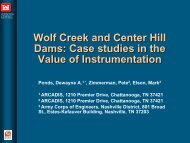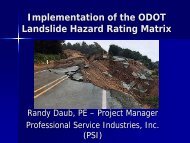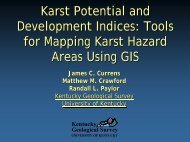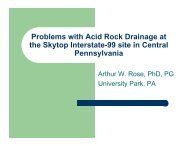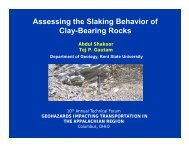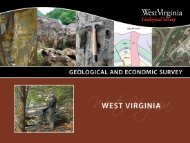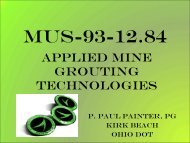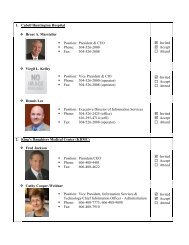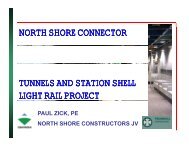Cone Penetration Testing (CPT)
Cone Penetration Testing (CPT)
Cone Penetration Testing (CPT)
Create successful ePaper yourself
Turn your PDF publications into a flip-book with our unique Google optimized e-Paper software.
<strong>Cone</strong> <strong>Penetration</strong> <strong>Testing</strong> (<strong>CPT</strong>)<br />
Michael Bailey, P.G.<br />
U.S. Army Corps of Engineers, Savannah District
Recommended publications<br />
• ASTM D 5778-07 Standard Test Method for Electronic<br />
Friction <strong>Cone</strong> and Piezocone <strong>Penetration</strong> <strong>Testing</strong> of<br />
Soils<br />
Recently updated standard describing state-of-the-practice equipment and<br />
procedures. Comprehensive guidance for operation and maintenance of <strong>CPT</strong><br />
equipment.<br />
• Lunne, T., Robertson, P.K. and Powell, J.J.M. (1997),<br />
<strong>Cone</strong> <strong>Penetration</strong> <strong>Testing</strong> in Geotechnical Practice,<br />
Blackie Academic/Routledge Publishing, New York.<br />
Thorough introduction to <strong>CPT</strong> history, theory and applications. Considered an<br />
essential resource by many <strong>CPT</strong> practitioners.
Traditional geotechnical soils investigations
• Drill rigs used to collect SPT or “undisturbed” samples.<br />
• Inconsistencies in sampling methodologies are common.<br />
• Disturbance of “undisturbed” samples is unavoidable and<br />
can compromise sample integrity.<br />
• Many opportunities to introduce error from sampling<br />
techniques to sample transport to laboratory extraction,<br />
handling and testing procedures.<br />
• Cost, $12 to $24 per foot (NCHRP findings), may be<br />
prohibitively expensive for detailed site investigations.<br />
Does not include laboratory testing costs.<br />
• Relatively time consuming to collect samples.<br />
• Spoils from drilling can create additional problems.<br />
• Main advantage<br />
– physical sample is collected.
<strong>CPT</strong> investigations
• Standard cone dimensions: tip 10<br />
cm 2 , sleeve 150 cm 2 , 1.44-inch<br />
diameter<br />
• Another common configuration: tip<br />
15 cm 2 , sleeve 225 cm 2 , 1.75-inch<br />
diameter<br />
• 5, 10, 15-ton load capacity cones<br />
most common<br />
• Tip resistance (q c )<br />
• Sleeve friction (f s )<br />
• Induced pore pressure and pore<br />
pressure dissipation (U 1,2,3 )<br />
• Shear wave velocity<br />
• Soil resistivity<br />
• Inclination<br />
• Temperature<br />
Source: NCHRP Synthesis 368
Source: NCHRP Synthesis 368
• <strong>CPT</strong> - Continuous sampling, 1cm vertical resolution.<br />
• Conservatively, 5 times faster than traditional drilling.<br />
• $6 to $9 per foot (NHCRP findings).<br />
• Superior accuracy and precision compared to typical<br />
drilling and testing.<br />
• Predicts many design parameters normally obtained by<br />
traditional drilling and sample testing.<br />
• Laboratory sampling requirements are greatly reduced<br />
for added cost savings.<br />
• No drilling spoils are generated.<br />
• Does not eliminate the need for drilling and testing, but<br />
can greatly reduce number of borings/samples.<br />
• Can collect additional data such as soil resistivity and<br />
shear wave velocity with little added cost.<br />
• Disadvantage – physical soil sample is generally not<br />
collected. Only used in unconsolidated sediments.
Accuracy and precision<br />
• Accuracy expressed as calibration non-linearity of strain<br />
gauges.<br />
• Typically 0.2 % of the full scale output (q c and f s ) and 0.5<br />
% of full scale for pore pressure.<br />
• Precision i is one of the hallmarks of <strong>CPT</strong>. Considering<br />
i<br />
strata heterogeneity, remarkable repeatability is<br />
achieved in side-by-side comparison soundings.<br />
• Precision of the tip readings is most reliable. Tip<br />
readings generally have the greatest design significance.
Interpreting results<br />
• When pore pressure is collected, referred to as piezocone<br />
or <strong>CPT</strong>u sounding. Three basic measurements q c , f s , u 2 .<br />
• q c is typically corrected for pore pressure effects (q t ).<br />
• q t = q c + u 2 (1-a), where a is net area ratio of tip, ranges<br />
from 0.6 to 0.8 depending on probe design.<br />
• Normalization for overburden stress.<br />
Q t = (q t -σ vo )/σ′ vo<br />
Fr = 100%[f s /(qt-σ σ vo )]<br />
Bq = (u 2 -u 0 )/(q t -σ vo ) = pore pressure parameter
Source: NCHRP Synthesis 368 (aftter<br />
Jamiolkowski et al. 1985)
Soil behavior type (SBT)<br />
Source: NCHRP Synthesis 368 (after Robertson et al. 1986)<br />
Source: Robertson and Campanella 1990
<strong>CPT</strong> predicted strength<br />
(using Nk = 11)<br />
Richard Olsen, PhD, PE USACE-ERDC<br />
Geo-Omaha Conference - Feb 15, 2008<br />
Richard Olsen, PhD, PE USACE-ERDC-GSL-GEGB<br />
Omaha District Citrus levee meeting 10Jan2008 at New Orleans
Estimated parameters from standard <strong>CPT</strong>u<br />
• Undrained shear strength, S u<br />
• Drained friction angle, phi<br />
• Stress History, OCR<br />
• Equivalent N 60<br />
• Coefficient of lateral earth stress, K o<br />
• Total density, relative density and void ratio, ρ , D R , e o<br />
• Constrained modulus, M<br />
• Sensitivity, S t<br />
• Fines Content<br />
• Additional parameters
Undrained shear strength example<br />
• Theoretical solutions exist to<br />
predict a number of design<br />
parameters from <strong>CPT</strong> data<br />
including S u .<br />
• Another common method is to<br />
use site specific laboratory data<br />
to “calibrate” <strong>CPT</strong> results.<br />
• Limited number of borings done<br />
under tight QA/QC.<br />
• Laboratory results used to<br />
derive factors that are applied to<br />
<strong>CPT</strong> data to produce a best fit<br />
with lab data.<br />
• Factors are then applied to<br />
• Factors are then applied to<br />
larger number of <strong>CPT</strong><br />
soundings.
Pore pressure dissipation<br />
• Pore pressure measured<br />
during push is induced by<br />
probe displacing saturated soil.<br />
• When push is paused, rate of<br />
dissipation is linked to the<br />
coefficient of consolidation<br />
(c vh ), which is linked to<br />
hydraulic conductivity (k).<br />
Where: D’ = constrained modulus, a = cone<br />
radius, I R = rigidity index, T 50 = time factor<br />
based on cone radius<br />
Source: NCHRP Synthesis 368
Source: NCHRP Synthesis 368



